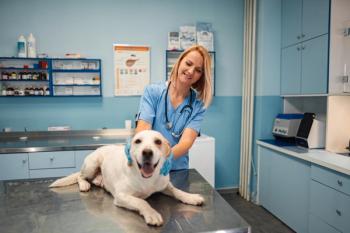
Behavior medicine: Easing patient fear
Fearful and anxious pets require a gentle approach in the clinic or hospital, to minimize and hopefully reduce the pet's fear and prevent escalation.
Many dogs are fearful when they visit the veterinary hospital. Fearful and anxious pets require a gentle approach by you and your staff to minimize and hopefully reduce the pet's fear and prevent escalation. Interactions should focus both on safety and remaining calm and positive. Where necessary, management products and pharmacological intervention may be required for increased safety of veterinary personnel and owners, as well as to enhance a dog's emotional well being.
Defusing anxiety: If the dog is trained to wear one, use of a head halter can help minimize stress in the waiting room.
Canine communication of anxiety or fear
Observation and detection of signs of conflict and anxiety are necessary to understand the dogs underlying emotional state so that precautions can be implemented to ensure safety and prevent further aggravating the problem. Dogs rarely react without warning; they just communicate in a way that humans may fail to recognize. Watch your patients closely for subtle signs such as licking, yawning, drooling, ears held back, looking away, trembling, tail low and tucked, or trembling. Some dogs freeze or stiffen. This absence of movement may not be easy to appreciate but may be the last warning before a serious bite is inflicted. Signs such as crouching, exposing the belly, submissive urination, mouthing, urine marking, lip lifting, raised hackles, escape attempts and growling may indicate a higher level of anxiety and distress. Some dogs display attention-seeking behaviors such as whining, barking, climbing on family members and even mounting.
Muzzles: can offer safety to staff and help keep the animal calm during the examination.
Do no harm
When pets exhibit fear and anxiety, the response of the veterinarian, staff and pet owner can further aggravate or lessen the pet's fear. Dogs are keen observers and quick learners, especially when the outcome is unpleasant. If the client is tense or worried, the fear can be heightened by their owner's response. Some clients harshly reprimand or punish fearful behaviors, which only serves to intensify the dog's fear and could even lead to defensive aggression. Another concern about punishment is that it might suppress the fearful behavior such as growling, but does not address the underlying motivation.
Reducing visual stimuli is an effective means of controlling anxiety.
The veterinarian or staff can further aggravate the problem by their own fear, anxiety, frustration or anger. These may be natural, uncontrollable, reflexive or necessary responses to a dog's threatening behavior, but they "validate" the dog's anxiety. Confrontational restraint and painful procedures further condition a fearful association with the veterinary visit. In addition, while retreat and avoidance may be necessary for safety, they teach the dog that aggression is successful at removing the threat (negative reinforcement).
In short, if every time a person with a "white coat" enters the room a family member tenses, tightens on the leash or scolds the dog, or you or your staff show fear or anxiety, this communicates to the dog that the white-coated person is a threat. Furthermore if the growling has been suppressed by punishment and the aggression has successfully caused you or your staff to retreat, the dog may learn to bite without warning. This is not a control or pack leadership problem or due to the dog being "spoiled" – educate about learning principles and methods to alleviate the dog's fear.
Sedation protocols for difficult dogs
Reducing anxiety in the fearful pet
Patients displaying subtle signs of fear may be improved with patience, food treats, toys and the use of a pheromone (DAP®) in the examination room. Offer high value food rewards. Try cheese spread or peanut butter (if there are no owner allergies) on a wooden spoon. These are highly palatable, occupy the pet longer than single treats, and keep staff and family further away for safety. Be sure to identify even mildly fearful dogs in your medical records. For further visits, fasting the pet before the visit and having the owner bring along favored food treats or toys may distract the pet and make the visit enjoyable if the anxiety is not too intense. Giving a benzodiazepine one to two hours prior to a visit and placing DAP spray on a blanket during the car ride may reduce anxiety and increase the pet's interest in taking treats.
Tools and techniques
Use handling and restraint techniques which minimize stress for the patient while providing optimal safety for your staff. Preparation, a calm attitude and proper tools can turn a potentially negative situation into one that is positive and safe. For dogs that are difficult to restrain and potentially aggressive, the primary goals are to ensure safety and to minimize fear and anxiety for the pet. If the dog is trained to wear a head halter or a basket muzzle prior to the visit, often the procedures can be accomplished with a minimum of fear or anxiety for all. The Not only does a head halter allow for a safe and calm examination, dogs that are food motivated can be distracted with favored treats while gently restraining the head. This technique is displayed on the
Pharmaceutical management
Avoid waiting too long for pharmacological intervention; stress, elevated heart rate and fear are detrimental to the pet and may alter the efficacy and doses needed for sedation. Benzodiazepines (e.g., diazepam, alprazolam, lorazepam) given in advance of the visit may provide anxiety relief, reduce arousal and provide a desirable amnesia effect. For increased sedation, acepromazine or phenobarbital can be added. However, for the more fearful patients intramuscular sedation is likely to be most practical either for minor procedures or as a premedication for anesthesia. Use of a head halter or basket muzzle should allow for safe administration. A combination of a narcotic such as morphine or hydromorphone, a low dose of medetomidine or dexmedetomidine (if there is no cardiac contraindication), plus the use of midazolam (which might have both an anxiolytic and amnesic effect) will usually be effective. Each of these components can be reversed should the need arise. Buprenorphine or butorphanol can be used as an alternative to the narcotic but cannot be reversed. For more difficult dogs additional dexmedetomidine can be used or Telazol (teletamine/zolazapam) can be added. Quiet environments promote successful induction with lower, safer doses. For details and doses, see the VIN FAQ on Handling and Restraint of Difficult Pets by Dr. Robert Stein, the chapter by Dr. Moffat in the September 2008 issue of Veterinary Clinics of North America, or by visiting
Triage for long-term behavioral health
Include both medical and behavioral triage in your treatment plan. Assess your patient, the urgency of medical procedures and the likelihood of a fearful outcome. If the procedure is not necessary (e.g. nail trim), it may be best postponed. However, if the procedure is necessary and likely to cause fear or discomfort (e.g. ocular examination, anal-sac expression), then develop a medical and behavioral plan, using management tools and drugs where necessary. Negative experiences are likely to have a lasting impact for future visits. By promoting gentle and positive handling and avoiding negative experiences, the result may be a patient that enjoys coming to the veterinary hospital.
by Gary Landsberg, BSc, DVM, Dipl. ACVB, Dipl. ECVBM-CA Dr. Landsberg practices at North Toronto Animal Clinic, Thornhill, Ont., Canada.
For a complete list of articles by Dr. Landsberg, visit
by Theresa DePorter, DVM Dr. DePorter has been providing consultations for behavior problems in the Southeastern Michigan area since 1995. She has spent more than 14 years independently studying the interaction of animal health, pet behavior and the human-animal bond. She received her DVM degree from Purdue University in 1992.
Newsletter
From exam room tips to practice management insights, get trusted veterinary news delivered straight to your inbox—subscribe to dvm360.






